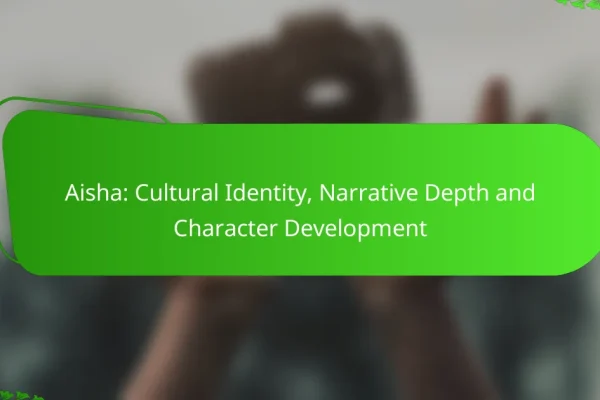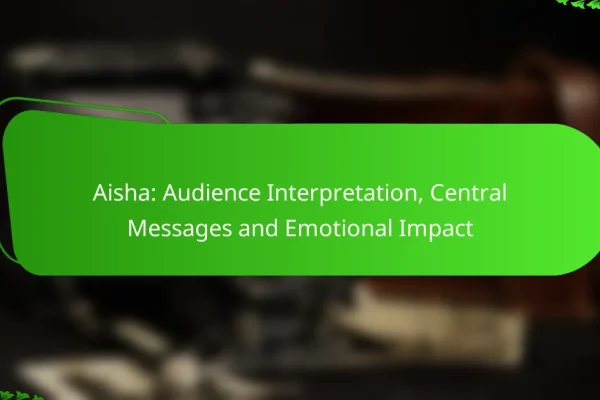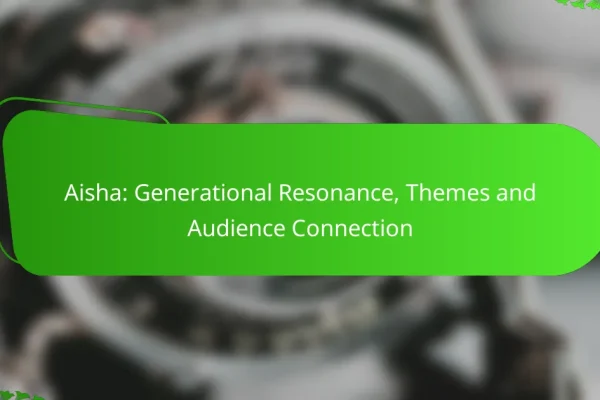What are the key themes in Aisha?
The key themes in Aisha include identity and self-discovery, cultural heritage and tradition, gender roles and empowerment, family and relationships, and social justice and activism. Each theme plays a crucial role in shaping the narrative and character development throughout the story.
Identity and self-discovery
Identity and self-discovery are central to Aisha’s journey as she navigates her personal and cultural complexities. The character’s quest for self-understanding often leads her to confront societal expectations and her own desires.
This theme encourages readers to reflect on their own identities and the influences that shape them, highlighting the importance of introspection and personal growth in a rapidly changing world.
Cultural heritage and tradition
Cultural heritage and tradition are depicted as both a source of strength and a challenge for Aisha. The story illustrates how cultural practices can enrich personal identity while also imposing limitations.
Through Aisha’s experiences, readers gain insight into the significance of preserving cultural traditions and the tension that can arise when individuals seek to forge their own paths.
Gender roles and empowerment
Gender roles and empowerment are critically examined in Aisha, showcasing the struggles women face in a patriarchal society. The narrative highlights Aisha’s fight against traditional gender expectations and her pursuit of autonomy.
This theme serves as a call to action for readers to challenge societal norms and advocate for gender equality, emphasizing the importance of empowerment in achieving personal and collective goals.
Family and relationships
Family and relationships play a pivotal role in Aisha’s development, illustrating the complexities of familial bonds and their impact on personal choices. The dynamics within Aisha’s family reflect broader societal issues and individual aspirations.
The story encourages readers to consider how relationships shape identity and influence decisions, emphasizing the need for open communication and understanding within families.
Social justice and activism
Social justice and activism are woven throughout Aisha’s narrative, highlighting her commitment to advocating for change. The story addresses various social issues, prompting readers to engage with their communities and seek justice for marginalized groups.
This theme inspires action, encouraging individuals to become active participants in social movements and to recognize the power of collective efforts in driving meaningful change.
How do the themes in Aisha reflect contemporary issues?
The themes in Aisha resonate with contemporary issues by addressing social justice, identity, and the struggles of marginalized communities. These themes highlight the ongoing challenges faced by individuals in navigating societal expectations and cultural norms.
Representation of marginalized voices
Aisha emphasizes the importance of representing marginalized voices, showcasing the experiences of individuals often overlooked in mainstream narratives. By giving a platform to these voices, the story fosters empathy and understanding among diverse audiences.
For instance, characters from various backgrounds illustrate the complexities of their lives, revealing systemic barriers they face. This representation encourages discussions about inclusivity and the need for diverse perspectives in media.
Impact of cultural narratives
The cultural narratives presented in Aisha play a crucial role in shaping societal attitudes and beliefs. These narratives can either reinforce stereotypes or challenge them, influencing how communities perceive themselves and others.
By weaving in authentic cultural elements, Aisha invites viewers to reflect on their own cultural identities and the broader implications of these narratives. This reflection can lead to greater awareness and advocacy for change within society.
What messages does Aisha convey about gender equality?
Aisha emphasizes the importance of gender equality by showcasing the struggles and triumphs of women in a patriarchal society. The narrative illustrates how women can challenge societal norms and achieve empowerment through various means, particularly education.
Challenging stereotypes
Aisha confronts traditional gender roles by depicting female characters who defy expectations. These women take on leadership roles and pursue careers typically dominated by men, demonstrating that capabilities are not limited by gender. This portrayal encourages readers to question and dismantle stereotypes that restrict women’s potential.
For example, Aisha’s protagonist may excel in a male-dominated field, showcasing her skills and determination. Such representations serve as powerful reminders that women can thrive in any environment when given the opportunity.
Empowerment through education
The theme of education as a tool for empowerment is central to Aisha’s message about gender equality. The narrative illustrates how access to education enables women to gain knowledge, confidence, and independence. Education not only opens doors to career opportunities but also fosters critical thinking and self-advocacy.
In many contexts, including those similar to Aisha’s setting, educational initiatives targeting girls can lead to significant societal changes. Encouraging girls to pursue their studies can result in improved economic stability and a shift in community attitudes towards gender roles.
How are the themes in Aisha relevant to audiences in the UK?
The themes in Aisha resonate with UK audiences by highlighting issues of identity, belonging, and cultural diversity. These themes reflect the complexities of modern British life, where multiculturalism plays a significant role in shaping personal and collective experiences.
Connection to British multiculturalism
Aisha explores the intricacies of multiculturalism in the UK, showcasing how individuals navigate their identities within a diverse society. The characters often face challenges related to cultural expectations and integration, mirroring the experiences of many in the UK who belong to different ethnic backgrounds.
This connection is particularly relevant in urban areas like London, where a rich tapestry of cultures coexists. The narrative encourages audiences to reflect on their own experiences with diversity and the importance of understanding and acceptance in a multicultural landscape.
Reflection of modern societal challenges
The themes in Aisha also address contemporary societal challenges such as discrimination, social inequality, and mental health. These issues are prevalent in the UK, where discussions around race and identity are increasingly important in public discourse.
By portraying characters who grapple with these challenges, Aisha prompts audiences to consider the impact of societal pressures on individual lives. This reflection can foster empathy and encourage conversations about how to address these pressing issues within the community.
What literary techniques enhance the themes in Aisha?
Literary techniques such as symbolism, imagery, and character development play a crucial role in enhancing the themes in Aisha. These techniques deepen the reader’s understanding of the narrative and its underlying messages.
Symbolism and imagery
Symbolism and imagery in Aisha serve to create a vivid representation of the characters’ emotions and experiences. For instance, recurring motifs like the sea may symbolize freedom and the longing for escape, while contrasting imagery of urban life can depict confinement and struggle. This duality enriches the thematic exploration of personal versus societal expectations.
Effective use of imagery allows readers to visualize key moments, making the emotional weight of the story more impactful. Descriptive passages that evoke sensory experiences can draw readers into the characters’ world, reinforcing the themes of longing and identity.
Character development
Character development is integral to conveying the themes in Aisha, as it illustrates the growth and transformation of the protagonist. As Aisha navigates her challenges, her evolving relationships and decisions reflect broader societal issues, such as gender roles and cultural expectations. This evolution not only engages the reader but also emphasizes the theme of self-discovery.
Moreover, supporting characters often serve as foils to Aisha, highlighting her struggles and aspirations. Their interactions provide insight into the societal norms that shape her journey, making the themes of resilience and empowerment more relatable and poignant.
How does Aisha compare to other works in its genre?
Aisha stands out in its genre by blending traditional themes with contemporary issues, creating a unique narrative experience. Unlike many works that focus solely on cultural identity, Aisha delves into personal growth and societal challenges, making it relatable to a broader audience.
Character Development
The characters in Aisha are intricately developed, showcasing a range of emotions and growth throughout the story. This depth allows readers to connect with their struggles and triumphs, which is often a hallmark of successful narratives in this genre. In contrast, some similar works may rely on archetypal characters that lack this level of complexity.
Themes of Identity and Belonging
Aisha explores themes of identity and belonging through the protagonist’s journey, reflecting the challenges faced by individuals in a multicultural society. The narrative emphasizes the importance of self-discovery and acceptance, which resonates with readers who may experience similar conflicts. Other works in the genre may touch on these themes but often do so in a more superficial manner.
Social Commentary
Aisha provides a poignant social commentary on issues such as gender roles and cultural expectations. This critical perspective encourages readers to reflect on their own societal norms and values. While some works may address social issues, Aisha’s approach is more integrated into the storyline, making it a compelling read.
Writing Style and Structure
The writing style in Aisha is characterized by vivid imagery and emotional resonance, which enhances the storytelling experience. The narrative structure is often nonlinear, allowing for a deeper exploration of the characters’ backstories and motivations. This contrasts with more straightforward narratives in the genre, which may follow a predictable plotline.












